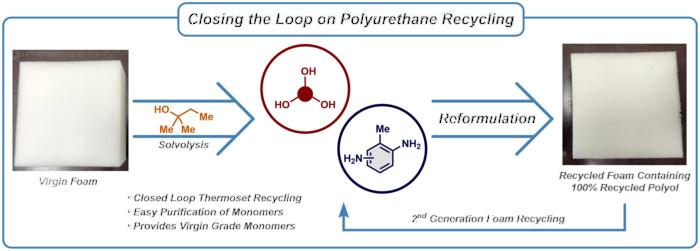It created something of a stir when, back in 2022, researchers from Aarhus University announced a new and inexpensive way of breaking down polyurethane (PU) plastic into its original components, which can then be recycled into new PU material instead of ending up in landfills or incinerators.

Credit: Aarhus University
It created something of a stir when, back in 2022, researchers from Aarhus University announced a new and inexpensive way of breaking down polyurethane (PU) plastic into its original components, which can then be recycled into new PU material instead of ending up in landfills or incinerators.
Now, together with Plixxent A/S, Dan-Foam Aps and the Danish Technological Institute as part of the Danish RePURpose consortium, the same researchers have proven that the method can be used to tackle flexible foam polyurethane:
They have broken down approx. one-and-a-half kilos of foam mattress, extracted its main components and used one of them, polyol, as a raw material in a new piece of mattress. By replacing “fresh” polyol, which is primarily produced from crude oil, with polyol extracted from the old mattress, the researchers have replaced 64 per cent of the mattress, without impairing quality in any way.
They have also demonstrated that the process can be repeated several times. In other words, the polyol can be re-extracted from polyurethane foam and reused again.
The results have just been published in the scientific journal ACS Sustainable Chem & Eng, which is published by the American Chemical Society.
Much needed solution
This takes us a step further towards a circular economy for flexible PU foam. And it is desperately needed.
The vast majority of global PU waste is deposited in landfills because it is difficult to recycle. PU cannot be melted, and for this reason it is not possible to simply mould it into new products like many other plastics.
The global market for PU was 24.7 million tonnes in 2021, and it is expected to exceed 29 million tonnes by 2029. The flexible PU foam used in mattresses accounts for about 30 per cent of the market.
PU is not only used in mattresses; it is a group of advanced plastic materials with many different properties and even more applications. It is also used in furniture, refrigerators, shoes, toys, paints, fillers, insulation, cars, wind turbines, aircraft and much more.
Requires waste control
The method developed and patented by the chemists at Aarhus University is called solvolysis, and breaks down the chemical bonds in PU by putting the material in a sort of pressure cooker with hot tert-amyl alcohol and a little caustic potash.
However, the researchers do not expect that this process can be used for the entire PU market. The different types of PU are too different.
“Our technique can push society towards a circular economy for PU mattresses. But if recycling is to put and end to landfilling and incineration, industry and society need full control of waste streams. The problem is that each manufacturer of PU-based materials has its own unique recipe,” says Assistant Professor Steffan Kvist Kristensen from the Interdisciplinary Nanoscience Center (iNANO) at Aarhus University, who is a co-author of the study.
Journal
ACS Sustainable Chemistry & Engineering
DOI
10.1021/acssuschemeng.3c01469
Subject of Research
Not applicable
Article Title
Closed-Loop Recycling of Polyols from Thermoset Polyurethanes by tert-Amyl Alcohol-Mediated Depolymerization of Flexible Foams
Article Publication Date
7-Jul-2023
COI Statement
The authors of the study declare the following competing financial interests: Aarhus University and the Technological Institute have patented the tert-amyl alcohol process for breaking down polyurethane.




